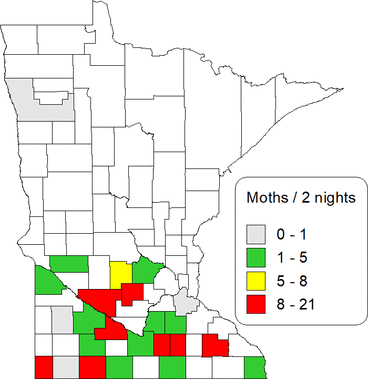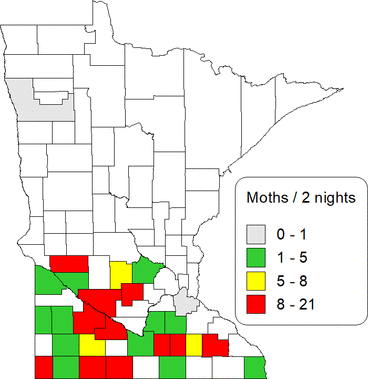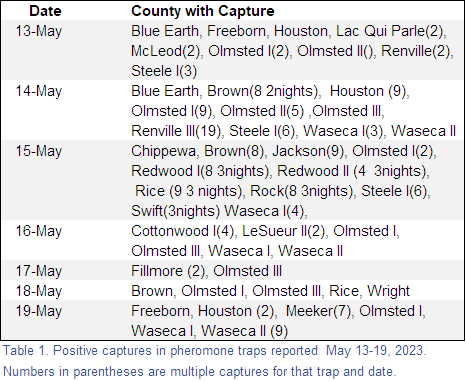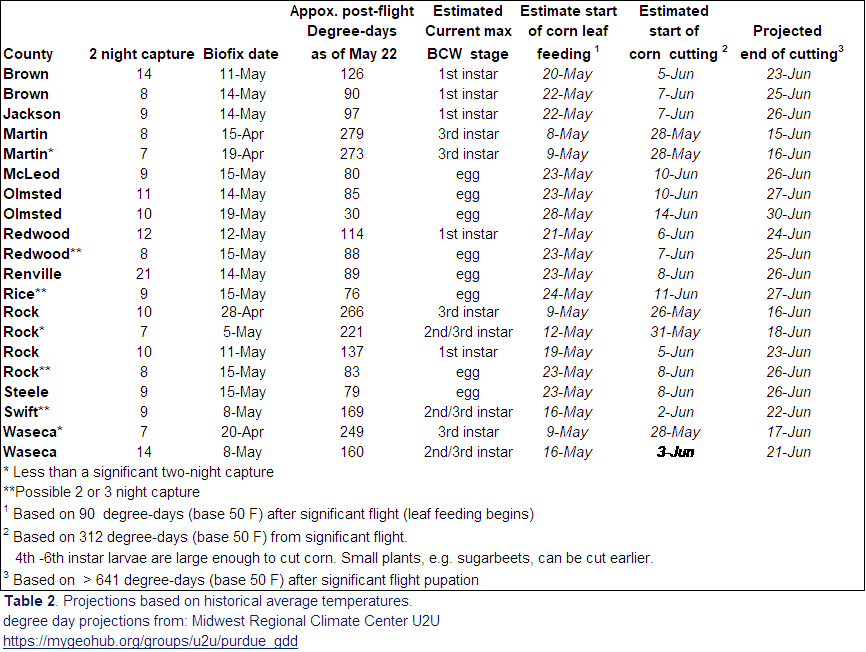2023 University of Minnesota Cooperative
Black Cutworm Trapping Network
For more information: https://z.umn.edu/bcw-reporting
May 23, 2023
Greetings:

Trap activity is winding down as planting is completed in areas. For others, planting still has a way to go. A dry week should help get some fieldwork done and planting (or replanting) of some of the wet areas can happen. Weed emergence is heavy in some fields. Keep low-lying and weedy areas in mind when scouting.
Black cutworm (BCW) activity in pheromone traps continued as weather systems brought both rain and moths. There were multiple traps with significant moth flights (Figure 1, Table 1). Some of these (Redwood, Rice, Rock) were three-night weekend captures but likely occurred over just one or two nights. Over the 13th and 14th one of the traps in Renville County had a concerning 21 moths / 2-night capture!
More so than many years, 2023 has been active for BCW flights into Southern Minnesota (Figure 2). Several counties had significant captures (8 or more moths/2 nights) and some counties had multiple events (Table 2). This does mean that economic losses from BCW are certain, but it does mean that awareness of cutworms is important when scouting this year.

Leaf feeding from the earlier, significant BCW flights on corn or weeds should be underway now. Based on accumulated degree days, black cutworm larvae from the earlier significant flights detected by Martin, Rock, and Waseca County traps will be large enough to cut small corn by the end of May (Table 2). The larvae from the mid-May flights will not be large enough to cut corn until after the 1st week of June. These dates are only guidelines. The degree day models often over predict because egg-laying occurs over several days and residue and soil moisture can affect temperatures. Early planted corn may be able to outgrow the larvae from some of these later arriving BCW larvae.
I gave suggestions on prioritizing corn fields for scouting in the previous issue. While soybeans can compensate for lost stand better than corn, large BCW populations can still devastate areas of soybean stands. Some of the large flights in 2022 were detected in the area of southern Minnesota where sugarbeets are grown.
Leaf feeding will provide a clue to cutworm presence. Cut plants and larvae ID and size are used to determine the need for insecticide treatment.
The need for cutworm management keys on desired final stands balanced against the time larvae have left to feed. Generally, with high corn prices 1 % wilted or cut and small larvae or 2-3 percent plants wilted or cut with large larvae. This, of course, depends on the starting stand, and poor emergence will influence decisions.
Other crops such as sugarbeets and soybeans also rely on desired stand when making insecticide treatment decisions.
See more details in the thresholds section here: https://extension.umn.edu/corn-pest-management/black-cutworm.
A printable PDF along with previous reports can be found https://swroc.cfans.umn.edu/research/ipm/bcw-network.


True armyworm (TAW) moths continue to be active in trap captures. Feeding on nectar to keep their energy up, male and female moths can mate multiple times. The females can lay more than 1,500 eggs over a week or more. It takes about three weeks for eggs to hatch and fifth-stage larvae to develop. The fifth and especially the sixth stage larvae consume the most foliage and will move in large numbers when they run out of food. Therefore, it is best to find TAW infestations early as large numbers of large larvae can cause a crop to disappear, seemingly overnight.
The 2023 true armyworm moth captures still represent an elevated risk for armyworm issues in grass crops. Whether a problem develops will depend on weather and natural enemies. For scouting and management tips for armyworms see https://extension.umn.edu/corn-pest-management/armyworm.
Please let me know if you become aware of fields with cutworm or armyworm problems.
Until next week,
Bruce
